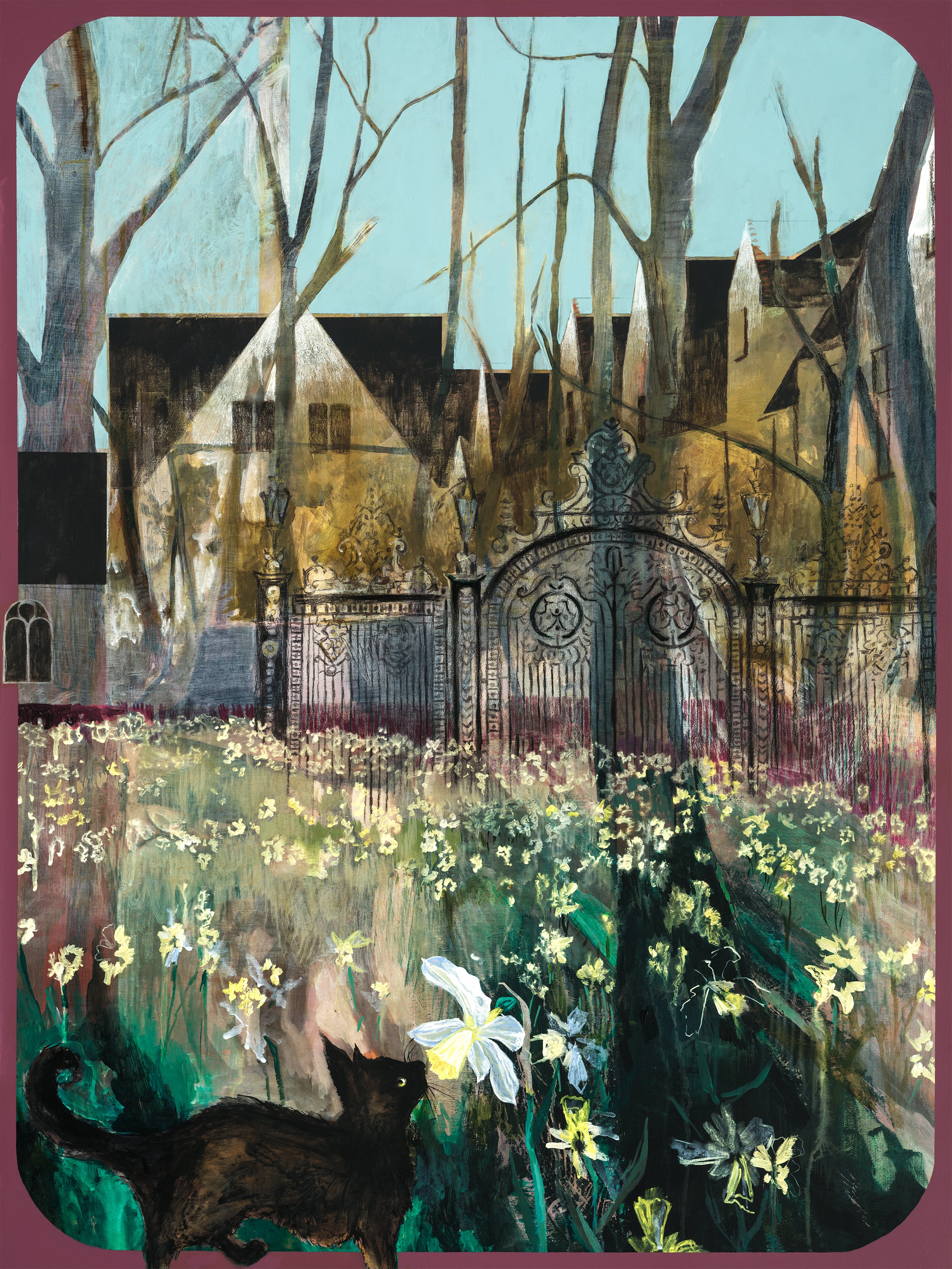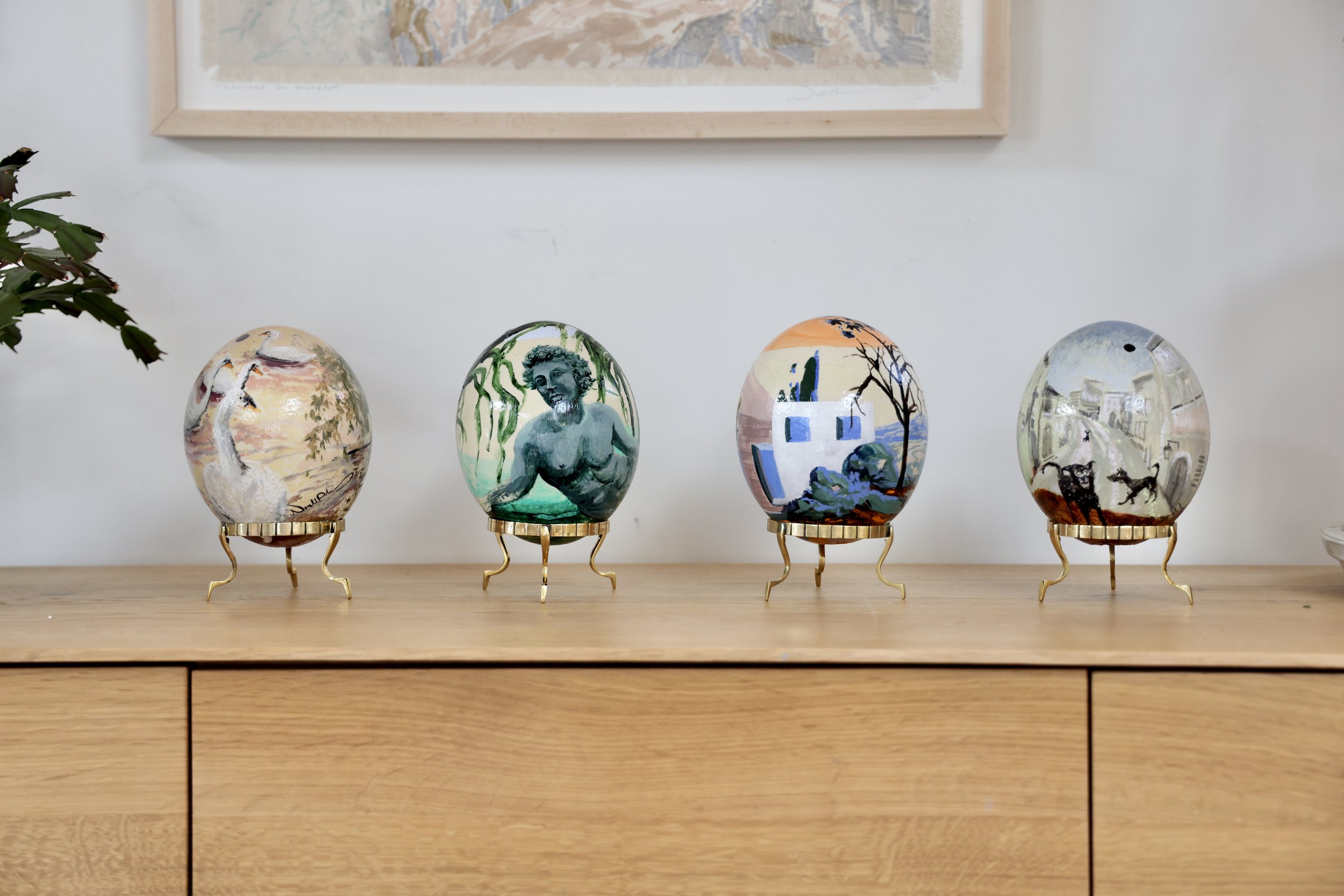Noelle Phares’s newest body of work entitled “Salty and Dark” represents a departure from her typical focus on environmental impacts to landscape, turning instead towards more personal subjects. The 22 paintings in the collection originate from a residence in southern France and include works on panel, St. Mary’s cotton canvas, and ostrich egg. Phares, who has some French heritage, was pregnant with her first child at the time and sees the work as a meditation on the mixture of complicated feelings she held around motherhood and what the landscapes of the area evoked in her during that time. The palettes are notably soft in comparison to the artists’ general work, and the compositions ripe with feminine symbolism including nods to florals, felines, and female portraiture while still centering primarily on landscape and area-specific architecture.
Says the artist about the work: “So much about that time felt salty and dark - I was greatly unsettled by what I perceived to be the impending restrictions of motherhood on my previously adventurous and freewheeling life while the physical toll of pregnancy felt suffocating. But after I met my little daughter I realized that there was a lot of beauty in that precious time. What grew inside me, nestled down in the salty and dark depths of my body, was a garden of delights. I think back to the time I spent in France with much fondness as it nurtured my spirit when I needed it most. The landscapes felt sacred to me, full of history and quiet beauty. Much of it was less manicured than other parts of France that I had visited previously and I recognized some of the wild, raw beauty that I felt blossoming in myself in the sprays of late summer wildflowers and rows of cypresses against parched hillsides. I think that time and place fostered in me a new recognition of the feminine spirit and the special nature of womanhood. Things stood out in my observations of the area that probably would not have otherwise - perhaps due to the heightening of certain senses, and thus the paintings I began in France and finished back at my studio in Colorado are imbued with that unique perception. I consider that time in France as a time that shaped and held me as I unknowingly formed my most wonderful creation yet.”
How to purchase:
The works will be available exclusively through the gallery and available to the public for purchase upon the exhibition opening at 6pm pacific time on July 11, 2025. The gallery ships worldwide. To inquire about a specific work in advance, or to make a purchase if you are not local and cannot attend in person please contact either of these humans directly:
Callie Jones (gallery director) | (214) 695-7047 | callie@colgallery.com
Jordan Pieper (exhibition curator) | (303)-704-2336 | jordan@jordanpieper.com
How to see the work:
The exhibition will open with a reception from 6-8pm on Friday, July 11. I will be there!
The exhibition runs from July 11 - September 6 2025 and may be visited by appointment during regular gallery hours.
887 Beach St.
San Francisco, CA 94109
Preview
Click the images for more views and information about each painting.
Set #1:
Three 30x40” paintings on panel, framed in cradled maple floaters (available separately)
Set #2:
Three 22x30” drawings / paintings on raw St. Mary’s Cotton, float mounted and framed in maple (available separately)
Set #3:
Three 24x24” paintings on raw St. Mary’s Cotton embroidered with French thread, float mounted and framed in maple (available separately)
Set #4:
Seven 11x14” paintings on linen (available separately)
The spirit of southern France felt very feminine to me. Creating this series offered a chance to explore that notion more. A number of the reference photos were taken by Émile Joachim Constant Puyo in the late 1800s/early 1900s, a French photographer credited with championing the practice of photography as an artistic medium. Also included is a reference to a portrait of poet Edna St. Vincent Millay, and a female farmer who I am connected to. Given what I was going through during the time of my French residency, I was hyper-focused on the unique traits of womanhood and my goal for this series was to highlight women as figures of not just inherent beauty, but of great strength and deep intellect. Each piece includes botanical elements as well as a nod to mother earth and the female capacity to nurture and grow entities beyond her physical self.
Set #5:
Set of five ostrich eggs on vintage brass stands
the Fabergé egg. More famously associated with Russia and the Imperial Easter Eggs, the Fabergé family’s origins are actually French. Unrelated but in addition, it was during the reign of Louis XIV, “The Sun KIng”, that decorated easter eggs emerged. Ostrich eggs from the Court of Versailles’s zoo were elaborately decorated, often with gold leaf, and distributed to the court during the holiday.
Fontaine, 4.5” x 5.5” | Acrylic on Ostrich egg on vintage brass stand




























